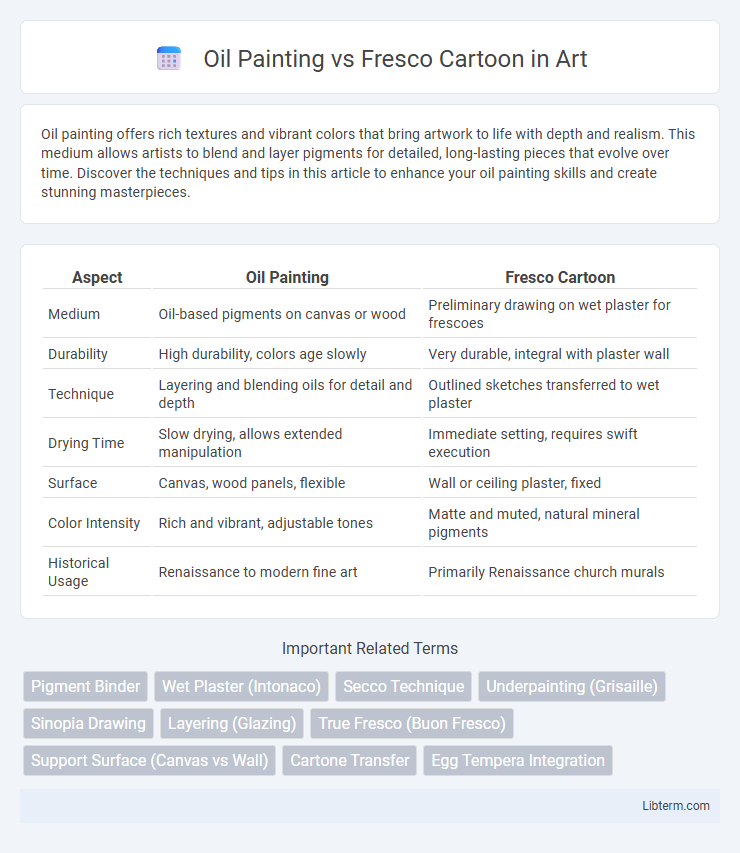Oil painting offers rich textures and vibrant colors that bring artwork to life with depth and realism. This medium allows artists to blend and layer pigments for detailed, long-lasting pieces that evolve over time. Discover the techniques and tips in this article to enhance your oil painting skills and create stunning masterpieces.
Table of Comparison
| Aspect | Oil Painting | Fresco Cartoon |
|---|---|---|
| Medium | Oil-based pigments on canvas or wood | Preliminary drawing on wet plaster for frescoes |
| Durability | High durability, colors age slowly | Very durable, integral with plaster wall |
| Technique | Layering and blending oils for detail and depth | Outlined sketches transferred to wet plaster |
| Drying Time | Slow drying, allows extended manipulation | Immediate setting, requires swift execution |
| Surface | Canvas, wood panels, flexible | Wall or ceiling plaster, fixed |
| Color Intensity | Rich and vibrant, adjustable tones | Matte and muted, natural mineral pigments |
| Historical Usage | Renaissance to modern fine art | Primarily Renaissance church murals |
Introduction to Oil Painting and Fresco Cartoon
Oil painting uses pigments mixed with oils like linseed, creating vibrant, flexible artwork that allows detailed textures and rich color blending. Fresco cartoon serves as a preparatory drawing on large surfaces, guiding the artist in applying pigment on wet plaster, crucial in mural fresco techniques. Both methods represent distinct artistic processes, with oil painting prioritizing longevity and depth, and fresco cartoon emphasizing planning and precision for wall art.
Historical Development of Each Technique
Oil painting originated in the early 15th century during the Northern Renaissance, pioneered by artists like Jan van Eyck, who perfected the use of linseed oil as a binder to achieve rich color and detailed textures. Fresco cartoon technique dates back to ancient times but was refined during the Italian Renaissance, with artists such as Michelangelo and Raphael using full-scale preparatory cartoons to transfer designs onto wet plaster surfaces for murals. Both methods evolved through centuries, influencing artistic expression by allowing greater detail and durability in oil paintings and large-scale public artworks in frescoes.
Core Materials and Tools Used
Oil painting relies on pigments suspended in oil, typically linseed oil, applied with brushes or palette knives on primed canvases or wooden panels. Fresco cartoon involves a full-scale preparatory drawing on paper or cloth, transferred onto freshly laid wet lime plaster using techniques like pouncing or incising for mural painting. Core tools for oil painting include fine brushes, palette knives, and mixing palettes, whereas fresco cartoon requires charcoals, sponges, and styluses for accurate design transfer.
Differences in Surface Preparation
Oil painting requires a primed surface, typically canvas or wood, treated with gesso to create a smooth, absorbent base that supports multiple layers of paint. Fresco cartoons are prepared on fresh, wet lime plaster walls, where pigments chemically bond with the plaster as it dries, creating a durable and integral surface. The key difference lies in oil painting's flexible, prepped support versus fresco's chemically reactive, wet plaster application.
Distinct Artistic Processes and Methods
Oil painting involves layering pigments suspended in oil, allowing rich color blending and extended drying times for detailed refinement. Fresco cartoon is a preparatory drawing applied onto wet lime plaster, requiring swift, precise execution before the plaster sets. The oil technique emphasizes texture and depth through glazing, while fresco cartoons prioritize linear composition and immediate transfer onto walls.
Color Application and Visual Effects
Oil painting utilizes layers of translucent pigments, allowing artists to achieve rich color depth, smooth gradients, and subtle blending that enhances realism and texture. Fresco cartoons employ direct application of pigments onto wet plaster, producing matte, durable surfaces with vibrant but less gradated colors that emphasize bold outlines and flat color fields. The oil method enables dynamic light interplay and meticulous detail, while fresco's visual effect relies on strong contrasts and textural integration with architectural surfaces.
Durability and Preservation Concerns
Oil paintings offer superior durability due to their use of oil-based pigments that penetrate surfaces and resist moisture, resulting in long-lasting vibrancy and less susceptibility to environmental damage. Fresco cartoons, while integral to mural preparation, are more vulnerable to deterioration as they rely on wet plaster, which can crack or fade over time without proper climatic conditions and conservation efforts. Preservation of fresco cartoons demands controlled humidity and temperature, whereas oil paintings benefit from protective varnishes and stable indoor environments to minimize oxidation and fading.
Notable Artists and Masterpieces
Oil painting boasts masterpieces like Leonardo da Vinci's "Mona Lisa" and Rembrandt's "The Night Watch," showcasing rich textures and deep color layering. Fresco cartoons, essential to murals such as Michelangelo's Sistine Chapel ceiling and Raphael's "The School of Athens," demonstrate precise preparatory drawings that guide the fresco painting process. Notable artists in fresco include Giotto and Masaccio, who revolutionized narrative depth in wall paintings during the Renaissance.
Suitability for Various Art Styles
Oil painting offers rich color depth and versatility, making it ideal for detailed realism, impressionism, and expressionism, while fresco cartoons excel in preparing murals with bold outlines suited for classical and religious themes. The oil medium allows for blending and layering techniques that accommodate fine textures and subtle shading, whereas fresco cartoons provide durability and a structured guide for large-scale narrative compositions. Artists choose oil painting for flexibility across diverse styles and fresco cartoons specifically for their suitability in transferring designs onto plaster surfaces in traditional mural art.
Choosing the Right Technique for Your Project
Selecting the right technique between oil painting and fresco cartoon depends on the project's durability requirements and surface type. Oil painting offers vibrant colors and flexibility, suitable for canvas or wood, while fresco cartoon involves applying pigments on wet plaster, ideal for wall murals with longevity. Considering environment exposure and desired texture ensures the best artistic outcome for your project.
Oil Painting Infographic

 libterm.com
libterm.com